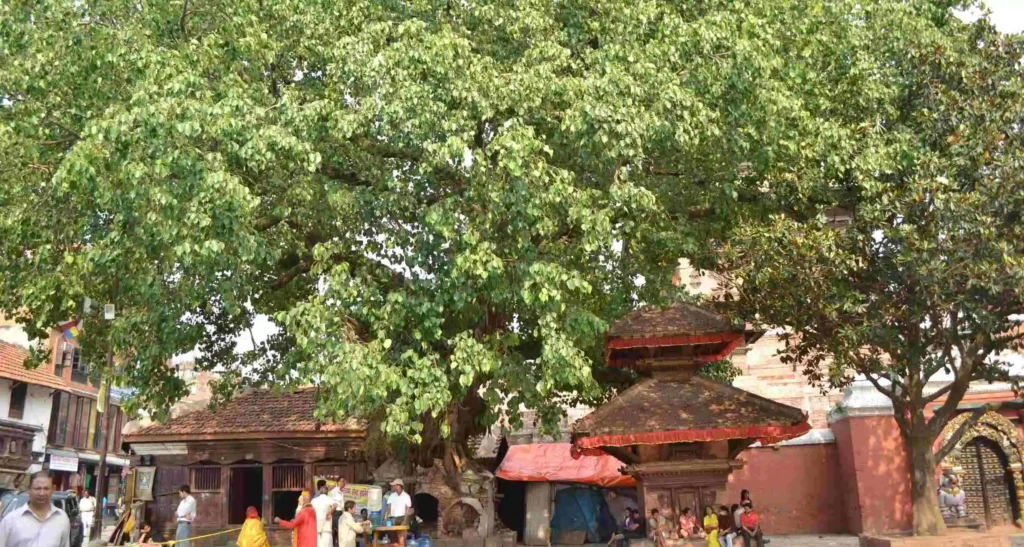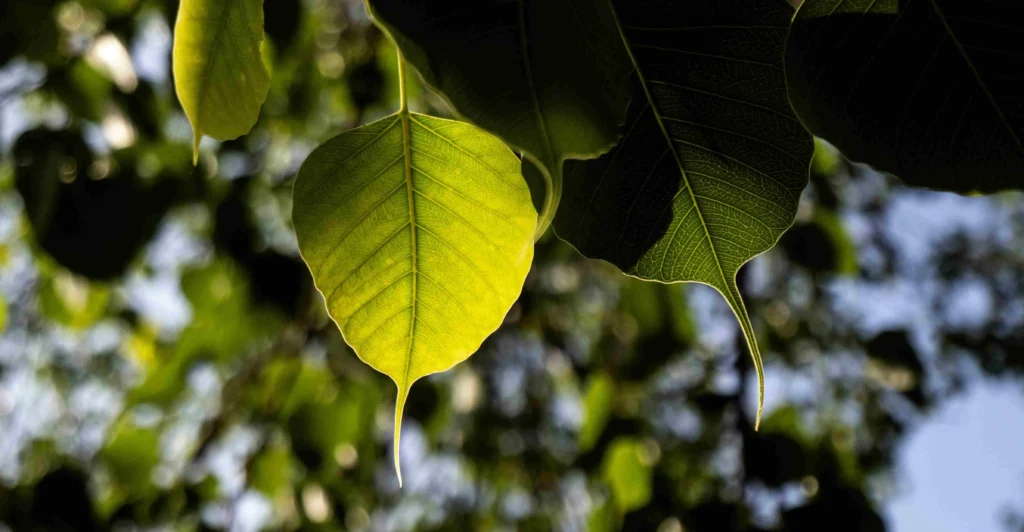Peepal Tree, scientifically known as Ficus religiosa, is not just a tree; it’s a living testament to the cultural, spiritual, and ecological wealth that our planet harbors. With its distinctive heart-shaped leaves and towering presence, the tree has carved its niche in history, mythology, and contemporary society. In this article, we will delve into the intricate side of the Peepal Tree, exploring its botanical features, spiritual significance, medicinal properties, and much more.
Table of Contents
Introduction
The Peepal Tree, also known as the Sacred Fig or Bodhi Tree, holds a special place in the hearts of many. Its scientific name, Ficus religiosa, reflects the reverence it commands. From ancient scriptures to modern environmental conversations, the Peepal Tree stands as a symbol of interconnectedness between nature and culture.
Botanical Features
At a glance, the Peepal Tree captivates with its broad, heart-shaped leaves and distinctive trunk. Its botanical features are not just aesthetically pleasing but also contribute to the tree’s ecological significance. The unique leaf structure, with a long petiole and fine venation, sets the Peepal Tree apart in the botanical realm.
Signature Heart-Shaped Leaves
The Peepal Tree is renowned for its heart-shaped leaves, a signature feature that sets it apart. These large, glossy leaves, with their unique shape and prominent veins, not only add to the tree’s aesthetic appeal but also play a crucial role in its ecological functions, capturing sunlight for photosynthesis.
Intricate Aerial Roots of Ficus Religiosa
One of the most striking features of the Bodhi Tree is its intricate aerial roots. These roots, descending from branches and reaching the ground, not only provide structural support but also contribute to the tree’s ability to adapt to various environments. Witnessing the aerial roots of this tree is akin to observing nature’s sculptors at work.
Fruits and Flowers of the Sacred Fig Tree
The Sacred Fig Tree bears small fig-like fruits, known as syconia, that hold tiny seeds. The figs, although not typically consumed by humans, serve as a crucial component in the tree’s reproductive cycle. The tree also boasts inconspicuous flowers, contributing to its overall botanical beauty.
Spiritual Significance
The spiritual significance of the Peepal Tree spans across various religions and cultures. In Hinduism, it is believed to be the dwelling place of Lord Vishnu, while Buddhists revere it as the tree under which Siddhartha Gautama attained enlightenment. The tree’s association with divinity has led to the incorporation of Peepal rituals and ceremonies in religious practices.
Also Read: Top 10 Interesting Facts About Peepal Trees
Ecological Importance
Beyond its cultural allure, the Peepal Tree plays a crucial role in environmental sustainability. It is known for its ability to provide shade, reduce air pollution, and support diverse ecosystems. Its wide-reaching branches create a microhabitat for various species, contributing to overall biodiversity.
Adaptability to Varied Environments
One remarkable aspect of the Peepal Tree is its adaptability to diverse environmental conditions. While it thrives in tropical and subtropical regions, it showcases resilience in different climates. This adaptability has contributed to the widespread presence of the Peepal Tree across continents.
Global Distribution
The Peepal Tree’s adaptability allows it to thrive in diverse climates globally. From the Indian subcontinent to Southeast Asia and beyond, its presence is a testament to nature’s ability to adapt and flourish.
Cultural Impact
The cultural impact of the Peepal Tree or Bodhi Tree extends beyond religious and traditional contexts. It has found its way into art, literature, and architecture, becoming a symbol that transcends boundaries. Exploring its influence provides insights into the dynamic relationship between culture and nature.

Medicinal Properties
The Peepal Tree is not just a spiritual entity; it also holds healing properties. Traditional medicine systems use Peepal leaves and bark for their antimicrobial and anti-inflammatory qualities. The tree’s contributions to alternative medicine underscore its holistic importance.
Antioxidant Richness of Peepal Leaves
The heart-shaped leaves of the Peepal Tree are more than just ornamental; they are a powerhouse of antioxidants. These antioxidants play a crucial role in neutralizing harmful free radicals in the body, contributing to overall well-being. Incorporating Peepal leaves into your health regimen can be a natural way to bolster your body’s defense mechanisms.
Peepal Leaves: Nature’s Antibacterial Agent
Peepal leaves also boast potent antibacterial properties. Studies have shown that extracts from Peepal leaves exhibit inhibitory effects against various bacteria. Incorporating leaf extracts into topical formulations or herbal remedies may aid in combating bacterial infections, providing a natural alternative to conventional treatments.
Peepal Leaves: Soothing Respiratory Woes
The Peepal Tree extends its healing touch to respiratory health. It is believed that consuming a concoction made from Peepal leaves can help alleviate respiratory issues such as cough and asthma. The natural compounds in the leaves work to soothe inflamed airways, providing relief to those grappling with respiratory discomfort.
Peepal Leaf Paste for Skin Ailments
In traditional medicine, a paste made from Peepal leaves is a popular remedy for skin ailments. The antibacterial and antifungal properties make it effective in addressing issues such as wounds, cuts, and skin infections. Applying a Peepal leaf paste can promote healing and alleviate discomfort.
Also Read: The Best Green Living Hacks From Peepal Tree
Common Myths and Legends
As with many ancient symbols, the Peepal Tree is surrounded by myths and legends. Stories of divine connections, curses, and supernatural occurrences add layers to its mystique. Exploring these myths offers a glimpse into the rich tapestry of cultural beliefs woven around the tree.
Eternal Nature of the Sacred Fig Tree
One enduring legend suggests the Peepal Tree’s immortality. According to folklore, the leaves of the Peepal never fall, symbolizing eternal life. This belief fosters a sense of reverence and awe, as the tree stands as a timeless witness to the ever-changing world.
Peepal Tree and the Butterfly Transformation
In some cultures, the Bodhi Tree is associated with the transformation of butterflies. Legend has it that the leaves of the tree are the dwelling places for these delicate creatures before they metamorphose into butterflies. This myth weaves a narrative of rebirth and metamorphosis.
A Keeper of Secrets and Mysteries
In some cultures, the Peepal Tree is considered a silent observer, privy to the secrets of the universe. Legends speak of seekers finding profound wisdom and enlightenment under its branches. The tree becomes a repository of ancient knowledge, imparting its insights to those who approach with reverence.
Growing and Caring Tips
For those looking to plant and nurture a Peepal Tree, understanding its growth requirements is essential. The tree thrives in well-drained soil and ample sunlight. Regular watering and occasional pruning contribute to its robust growth.
Urban Legends and Superstitions
Despite its positive attributes, the Peepal Tree has also been a subject of urban legends and superstitions. From being considered haunted to beliefs about spirits residing in its branches, these myths have persisted through generations, reflecting the complex relationship between humans and nature.
Peepal Tree as a Cosmic Axis
A captivating myth presents the Bodhi Tree as a cosmic axis, connecting the earthly realm with the heavens. Its towering branches reach towards the sky, creating a symbolic bridge between the mundane and the divine. Rituals performed under its shade are believed to have a direct link to celestial forces.
Taboos Surrounding Cutting the Peepal Tree
A widely held belief warns against cutting the Peepal Tree, considering it taboo in many cultures. It is believed that disrupting the tree disturbs the spirits residing within, inviting misfortune. This reverence for the tree underscores its spiritual importance and the need to treat it with utmost respect.
A Haven for Benevolent Spirits
The belief that benevolent spirits reside within the branches of the Scared Fig Tree is a prevalent myth. Many cultures view the tree as a sacred space where these spirits provide protection and guidance. The rustling leaves are often interpreted as whispers of these ethereal beings, creating an otherworldly connection.
Contemporary Uses
In the modern world, the Sacred Fig Tree continues to influence various aspects of life. Artists draw inspiration from its form, writers incorporate it into their narratives, and cultural references abound. The tree’s relevance persists in surprising and innovative ways.
Click here to read about “The Miraculous Anjeer Tree: Unveiling Its Health Secrets and Benefits!”

Preservation Efforts
With the increasing threat to ancient trees, conservation efforts are underway to protect this tree and its counterparts. Recognizing the importance of these living monuments, initiatives focus on creating awareness and implementing measures to ensure their preservation.
Conclusion
In conclusion, the Peepal Tree stands as a living symbol of cultural richness and environmental harmony. From its botanical features to spiritual significance, ecological contributions, and cultural impact, the Peepal Tree weaves a narrative that spans centuries. Preserving and celebrating this majestic tree is not just an environmental responsibility but a testament to the deep-rooted connection between humans and nature.
Frequently Asked Questions
Is the Peepal Tree really sacred in multiple religions?
Yes, the Peepal Tree holds significance in Hinduism, Buddhism, and Jainism, among other traditions.
Can the Peepal Tree be grown in urban environments?
Absolutely. With proper care, Peepal Trees can thrive in urban settings, providing environmental benefits.
Are there any specific rituals associated with the Peepal Tree?
Yes, various rituals involve circumambulating the tree, offering prayers, and tying threads around its trunk.
What are the potential health benefits of Peepal leaves?
Peepal leaves are believed to have antimicrobial and anti-inflammatory properties, contributing to their traditional medicinal use.
Why is the Peepal Tree considered significant in art and literature?
Its distinctive appearance and cultural symbolism make the Peepal Tree a recurring motif in artistic and literary expressions. Read more on Green Living with peepal tree.



